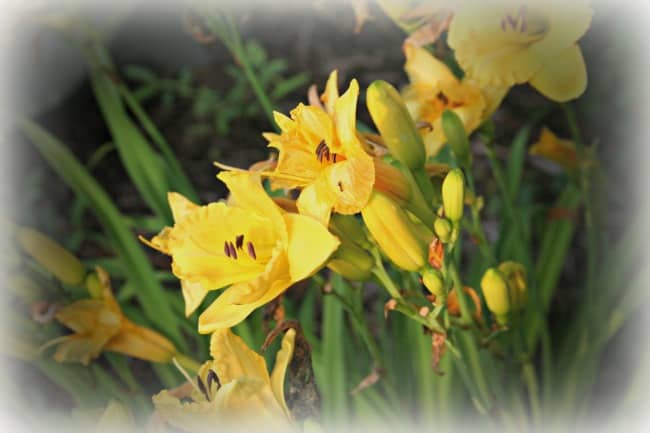Today, hubby and I completed our newest garden addition. We added another garden bed, this one over the septic drain field. It started when we had so many extra lilac bushes and phlox that Hubby just dug some holes in the lawn and planted them. Next followed crepe myrtle and crab apple tree seedlings. Voila. Instant garden.
We decided to finish off the area with a rock border similar to the natural borders we made in the flower garden near the driveway, my perennial garden. Collecting large rocks was easy; the man who built our house piled them in the woods on either side of the driveway, and once the rock piles were located under fallen leaves, it was a question of filling a wagon with them and using the tractor to haul them back to the garden.
The grass growing in the area, however, was another problem entirely. Hubby was all for using commercial landscape fabric to kill the grass and keep weeds from sprouting, but I wanted to try something I’d read about. I kept reading about using cardboard and paper to start vegetable gardens. The thinking goes that if you have lawn area and you want to transform it into garden, you lay down thick layers of cardboard and paper, then put soil or mulch over the area. Over time, the cardboard smothers the grass and breaks down into the soil, composting it while suppressing weeds. If you place soil over the cardboard, you can plant vegetables immediately. If you use mulch, you need to cut out holes in the cardboard for your plants.
We didn’t have much cardboard, but a neighbor had order some large furniture online and had huge cardboard boxes ready for the trash, so we asked him if we could have them and of course, he said yes. I mean, who hoards garbage? Hubby then cut them into the right shapes, since the garden bed has a natural, flowing edge to it (it’s not a straight-edged rectangle or square). We had some areas empty of cardboard, so on those areas, he used bits of landscape fabric left over from other projects.
Today we finished cementing together the stone edging. We decided to move a large butterfly bush “volunteer” growing in a tangle too close to the house, so we dug it up and trundled it back to the new garden area. A salvia that was also growing in a bad area was dug up as well, and so we needed to dig two planting holes in the new garden area.
The first hole we dug, we hit cardboard underneath. Hubby used a sharp knife to cut out the cardboard. Immediately, he drew back his hand and pointed to a nice cluster of baby earthworms wriggling under the cardboard. “Worms!” We’re always delighted when we find earthworms in the garden. It’s a sure sign of soil health, and here was proof that the composting method using cardboard worked! The soil underneath was soft and a little loamy, unusual with a clay leach field. I thanked the industrious worms, we planted the salvia, and moved on to the butterfly bush.
In this new area, we struck landscape fabric. Hubby used his trusty knife to cut out another circle. The soil underneath was visibly different from the area not four feet away. No earthworms, no insect life of any kind. Hard packed red clay that resembled bricks met our spade and shovel. It took a pickax to dig enough soil out for the butterfly bush.
I couldn’t help but ponder the difference between the two areas in my new garden bed, areas not four feet apart but worlds of difference in terms of soil health. Isn’t it amazing that something as inexpensive and easy as laying cardboard down could help boost soil health?
In the future, we’re going to use the cardboard method to transform other areas into gardens and suppress weeds. In the meantime, I hope my little earthworms enjoy their new salvia plant.





